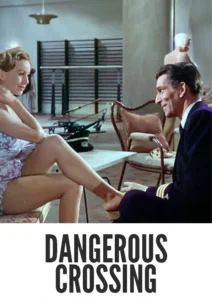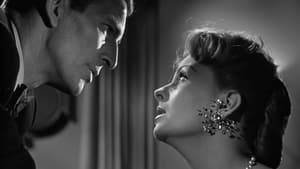Video Sources 0 Views
- Watch trailer
- Dangerous Crossing 1953 Colorized


Synopsis
Table of Contents
Toggle
Embark on a thrilling voyage into psychological suspense with Dangerous Crossing, a gripping film from 1953, now stunningly colorized to amplify its chilling atmosphere. Starring Jeanne Crain and Michael Rennie, this maritime thriller plunges you into a world of mystery, paranoia, and escalating dread aboard a transatlantic ocean liner. Perfect for fans of suspenseful cinema and those seeking a classic whodunit with a unique setting, this HD download offers a visually enhanced experience of a largely forgotten gem. Prepare to be captivated by a tale of deception, identity, and the terrifying unknown lurking on the open sea. Often referred to as High Seas, this suspenseful classic is a must-see.
Dangerous Crossing centers around Ruth Stanton (Jeanne Crain), a young bride on her honeymoon voyage from New York to Europe. Just hours after marrying her husband, John Bowman, he mysteriously disappears. To Ruth’s mounting horror, no one on board remembers John, and all evidence of his existence vanishes. The ship’s crew and passengers begin to question Ruth’s sanity, suggesting that John never existed at all and that she may be suffering from a mental breakdown.
Desperate to prove her husband’s existence and her own sanity, Ruth enlists the help of the ship’s doctor, Paul Manning (Michael Rennie). Together, they begin to unravel a sinister plot involving imposters, hidden identities, and a conspiracy that reaches the highest levels of the ship’s command. As Ruth and Dr. Manning delve deeper into the mystery, they uncover a dangerous network of criminals and a shocking truth that puts Ruth’s life in imminent danger. The film culminates in a suspenseful climax as Ruth confronts her adversaries and fights to expose the truth before she becomes the next victim. Dangerous Crossing is a tense and atmospheric thriller that explores themes of gaslighting, identity, and the fragility of reality.
The film boasts a talented cast that elevates this suspenseful narrative:
-
Jeanne Crain as Ruth Stanton Bowman
-
Michael Rennie as Dr. Paul Manning
-
Max Showalter as John Bowman (as Casey Adams)
-
Casey Adams as John Bowman (as Max Showalter)
-
Mary Anderson as Anna Quinn
-
Marjorie Hoshelle as Kay Prentiss
-
Bradford Eustis as Roberts
-
Will Wright as Captain
Dangerous Crossing expertly blends the genres of psychological thriller and maritime suspense, creating a unique and captivating cinematic experience. Its claustrophobic setting aboard a ship at sea heightens the sense of unease and paranoia, while its intricate plot keeps viewers guessing until the very end.
Released in 1953, Dangerous Crossing reflects the post-war fascination with suspense and psychological thrillers. The film taps into anxieties about identity, deception, and the unknown, which were prevalent themes in the era’s literature and cinema. Dangerous Crossing shares stylistic elements with film noir, including its use of shadows, dramatic lighting, and a sense of impending doom. While not strictly a film noir, it incorporates noir sensibilities to enhance its suspenseful atmosphere.
This colorized version of Dangerous Crossing has been meticulously restored, employing advanced digital techniques to enhance the visual impact while respecting the film’s original tone and atmosphere. The colorization process involved a detailed analysis of the original black and white footage, with careful consideration given to color palettes that would complement the film’s suspenseful themes. The result is a visually stunning experience that brings new depth and dimension to the story, immersing viewers in the world of Dangerous Crossing like never before. This careful colorization helps to introduce classic films to new generations, ensuring they are not forgotten.
-
: Joseph M. Newman
-
: Leo Townsend
-
: “Cabin B-13” by John Dickson Carr
-
: Joseph LaShelle
-
: William B. Murphy
-
: Twentieth Century Fox
-
: Twentieth Century Fox
-
: 75 minutes
-
: MP4
-
: HD (1080p)
-
: Compatible with most devices, including smartphones, tablets, computers, and smart TVs.
Dangerous Crossing (1953) is a compelling thriller that delivers a suspenseful and engaging viewing experience. Critics have praised Jeanne Crain’s performance as the increasingly desperate Ruth Stanton, as well as the film’s atmospheric setting and intricate plot. While it may not be as widely recognized as some of the era’s more famous thrillers, Dangerous Crossing remains a hidden gem that deserves to be rediscovered by fans of classic suspense cinema.
-
: What is Dangerous Crossing about?
-
A: Dangerous Crossing is a suspenseful thriller about a young bride whose husband disappears on their honeymoon voyage, leading her to question her sanity and uncover a sinister plot.
-
-
: Is Dangerous Crossing (1953) a well-known film?
-
A: While not as widely known as some classic thrillers, Dangerous Crossing is a highly regarded and suspenseful film that deserves greater recognition.
-
-
: Is this version of Dangerous Crossing colorized?
-
A: Yes, this version has been professionally colorized to enhance the viewing experience.
-
-
: What makes Dangerous Crossing interesting for thriller fans?
-
A: Dangerous Crossing offers a compelling blend of psychological suspense, maritime mystery, and a twisty plot that will keep viewers guessing until the end.
-
-
: What is the download format?
-
A: The download format is MP4, which is compatible with most devices.
-
-
: What resolution is the download?
-
A: The resolution is HD (1080p), providing a high-quality viewing experience.
-
Watch Dangerous Crossing Today!











